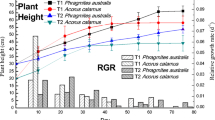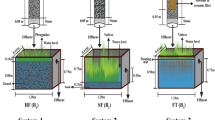Abstract
The aim was to assess the role of Phragmites australis (Cav.) Trin. ex Steud. in experimental, mature, and temporarily flooded vertical flow wetland filters treating urban runoff rich in organic matter. During the experiment, ammonium chloride was added to sieved concentrated road runoff to simulate primary treated urban runoff contaminated with nitrogen. Five days at 20°C N-allylthiourea biochemical oxygen demand (BOD) and chemical oxygen demand removal efficiencies were relatively lower for planted than unplanted filters. Moreover, there was no significant difference for BOD removal for all filters under fluctuating inflow concentrations of sulfate. The nitrogen removal performances of planted filters were more efficient and stable throughout the seasons compared to those of unplanted filters. A substantial load of nitrogen (approximately 500 mg per filter) was removed by harvesting P. australis. Plant uptake was the main removal mechanism for nitrogen during high concentrations (10 mg/L) of ammonia-nitrogen in the urban runoff.






Similar content being viewed by others
References
Allen, S. E. (1974). Chemical analysis of ecological materials. Oxford, UK: Blackwell.
American Public Health Association (APHA). (1998). Standard methods for the examination of water and wastewater (20th ed.). Washington, DC, USA: APHA-AWWWA-WEF.
Bezbaruah, A.N. (2002). Quantification of Oxygen Release by Plant Roots in Constructed Wetlands. Ph.D. Dissertation. Lincoln, NE, USA: University of Nebraska.
Bezbaruah, A. N., & Zhang, T. C. (2003). Performance of a constructed wetland with a sulfur/limestone denitrification section for wastewater nitrogen removal. Environmental Science & Technology, 37(8), 1690–1697. doi:10.1021/es020912w.
Birch, G. F., Matthai, C., Fazeli, M. S., & Suh, J. (2004). Efficiency of a constructed wetland in removing contaminants from stormwater. Wetlands, 24(2), 459–466. doi:10.1672/0277-5212(2004)024[0459:EOACWI]2.0.CO;2.
Caselles-Osorio, A., & Garcia, J. (2006). Performance of experimental horizontal subsurface flow constructed wetlands fed with dissolved or particulate organic matter. Water Research, 40(19), 3603–3611. doi:10.1016/j.watres.2006.05.038.
Kadlec, R., Knight, R., Vymazal, J., Brix, H., Cooper, P., & Haberl, R. (2000). Constructed wetlands for pollution control. Scientific and technical report number 8. London, UK: IWA.
Kadlec, R. H., Tanner, C. C., Hally, V. M., & Gibbs, M. M. (2005). Nitrogen spiraling in subsurface flow constructed wetlands: Implications for treatment response. Ecological Engineering, 25(4), 365–381. doi:10.1016/j.ecoleng.2005.06.009.
Kalra, Y. P. (1998). Handbook of reference methods for plant analysis. Florida, USA: CRC.
Kalyuzhnyi, S. V., & Fedorovich, V. V. (1998). Mathematical modelling of competition between sulfate reduction and methanogenesis in anaerobic reactors. Bioresource Technology, 65(3), 227–242. doi:10.1016/S0960-8524(98)00019-4.
Kao, J. T., Titus, J. E., & Zhu, W. X. (2003). Differential nitrogen and phosphorus retention by five wetland plant species. Wetlands, 23(4), 979–987. doi:10.1672/0277-5212(2003)023[0979:DNAPRB]2.0.CO;2.
Karathanasis, A. D., Potter, C. L., & Coyne, M. S. (2003). Vegetation effects on fecal bacteria, BOD, and suspended solid removal in constructed wetlands treating domestic wastewater. Ecological Engineering, 20(2), 157–169. doi:10.1016/S0925-8574(03)00011-9.
Kuo, W. C., & Shu, T. Y. (2004). Biological pre-treatment of wastewater containing sulfate using anaerobic immobilized cells. Journal of Hazardous Materials, B113(1–3), 147–155. doi:10.1016/j.jhazmat.2004.05.033.
Lee, B.-H., & Scholz, M. (2006a). What is the role of Phragmites australis in experimental constructed wetland filters treating urban runoff? Ecological Engineering, 29(1), 87–95. doi:10.1016/j.ecoleng.2006.08.001.
Lee, B.-H., & Scholz, M. (2006b). A comparative study: Prediction of constructed treatment wetland performance with K-nearest neighbours and neural networks. Water, Air, and Soil Pollution, 174(1–4), 279–301. doi:10.1007/s11270-006-9113-2.
Lim, P. E., Wong, T. F., & Lim, D. V. (2001). Oxygen demand, nitrogen and copper removal by free-water-surface and subsurface-flow constructed wetlands under tropical conditions. Environment International, 26(5–6), 425–431. doi:10.1016/S0160-4120(01)00023-X.
Meuleman, A. F. M., Beekman, J. P., & Verhoeven, J. T. A. (2002). Nutrient retention and nutrient-use efficiency in Phragmites australis after wastewater application. Wetlands, 22(4), 712–721. doi:10.1672/0277-5212(2002)022[0712:NRANUE]2.0.CO;2.
Meuleman, A. F. M., Van Logtestijn, R., Rijs, G. B., & Verhoeven, J. T. A. (2003). Water and mass budgets of a vertical-flow constructed wetland used for wastewater treatment. Ecological Engineering, 20(1), 31–44. doi:10.1016/S0925-8574(03)00002-8.
Poe, A. C., Pichler, M. F., Thompson, S. P., & Paerl, H. W. (2003). Denitrification in a constructed wetland receiving agricultural runoff. Wetlands, 23(4), 817–826. doi:10.1672/0277-5212(2003)023[0817:DIACWR]2.0.CO;2.
Reilly, J. F., Horne, A. J., & Miller, C. D. (2000). Nitrate removal from a drinking water supply with large free-surface constructed wetlands prior to groundwater recharge. Ecological Engineering, 14(1–2), 33–47. doi:10.1016/S0925-8574(99)00018-X.
Reinhardt, M., Muller, B., Gachter, R., & Wehrli, B. (2006). Nitrogen removal in a small constructed wetland: An isotope mass balance approach. Environmental Science & Technology, 40(10), 3313–3319. doi:10.1021/es052393d.
Sansalone, J. J. (1999). Adsorptive infiltration of metals in urban drainage—media characteristics. Science of the Total Environment, 235(1–3), 179–188. doi:10.1016/S0048-9697(99)00211-9.
Scholz, M. (2006a). Wetland systems to control urban runoff. Amsterdam, The Netherlands: Elsevier.
Scholz, M. (2006b). Best management practice: A sustainable urban drainage system management case study. Water International, 31(3), 310–319. doi:10.1080/02508060608691934.
Scholz, M., & Martin, R. J. (1998). Control of bio-regenerated granular activated carbon by spreadsheet modeling. Journal of Chemical Technology and Biotechnology (Oxford, Oxfordshire), 71(3), 253–261. doi:10.1002/(SICI)1097-4660(199803)71:3<253::AID-JCTB834>3.0.CO;2-Y.
Scholz, M., & Xu, J. (2002a). Comparison of constructed reed beds with different media and macrophytes treating urban stream water contaminated with lead and copper. Ecological Engineering, 18(3), 385–390. doi:10.1016/S0925-8574(01)00100-8.
Scholz, M., & Xu, J. (2002b). Performance comparison of experimental constructed wetlands with different filter media and macrophytes treating industrial wastewater contaminated with lead and copper. Bioresource Technology, 83(2), 71–79. doi:10.1016/S0960-8524(01)00210-3.
Silvan, N., Vasander, H., Karsisto, M., & Laine, J. (2003). Microbial immobilisation of added nitrogen and phosphorus in constructed wetland buffer. Applied Soil Ecology, 24(2), 143–149. doi:10.1016/S0929-1393(03)00092-1.
Tchobanoglous, G., Burton, F. L., & Stensel, H. D. (2003). Wastewater engineering: Treatment and reuse (4th ed.). New York, NY, USA: Metcalf and Eddy.
U.S. Environmental Protection Agency (EPA). (2000). Constructed Wetlands Treatment of Municipal Wastewater. EPA-625-R-99-010. U.S. EPA, Office of Research and Development: Cincinnati, OH, USA.
Verhoeven, J. T. A., & Meuleman, A. F. M. (1999). Wetlands for wastewater treatment: Opportunities and limitations. Ecological Engineering, 12(1–2), 5–12. doi:10.1016/S0925-8574(98)00050-0.
Vymazal, J. (2002). The use of subsurface constructed wetlands for wastewater treatment in the Czech Republic: 10 years experience. Ecological Engineering, 18(5), 633–646. doi:10.1016/S0925-8574(02)00025-3.
Vymazal, J., & Krasa, P. (2003). Distribution of Mn, Al, Cu and Zn in a constructed wetland receiving municipal sewage. Water Science and Technology, 48(5), 299–305.
Wiessner, A., Kappelmeyer, U., Kunschk, P., & Kästner, M. (2005). Sulphate reduction and the removal of carbon and ammonia in a laboratory-scale constructed wetland. Water Research, 39(19), 4643–4650. doi:10.1016/j.watres.2005.09.017.
Acknowledgments
The authors wish to acknowledge the financial support provided by the “UK/China Postgraduate Research Scholarships for Excellence” initiative for Dr Xiaohui Wu, who undertook most of the laboratory work. Further thanks go to Mr. Byoung-Hwa Lee, Mrs. Sara Kazemi-Yazdi, Mr. Paul Eke, and Mr. Piotr Grabowiecki for their practical support.
Author information
Authors and Affiliations
Corresponding author
Rights and permissions
About this article
Cite this article
Scholz, M., Hedmark, Å. Constructed Wetlands Treating Runoff Contaminated with Nutrients. Water Air Soil Pollut 205, 323–332 (2010). https://doi.org/10.1007/s11270-009-0076-y
Received:
Accepted:
Published:
Issue Date:
DOI: https://doi.org/10.1007/s11270-009-0076-y




